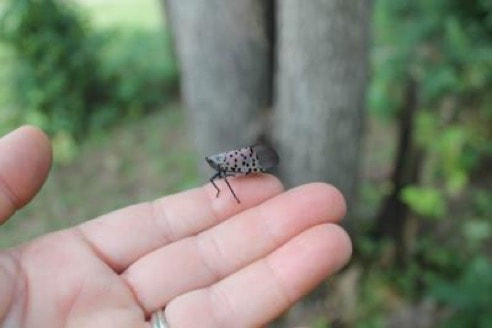 Spotted lanternflies pose a threat to plants' photosynthesis By Mary Stickley-Godinez, May 25, 2020, The Daily Progress The adult spotted lanternfly is a beautiful moth-looking creature, silvery gray with charcoal highlights and bright red accents. Covid-19 is not the only thing that has come to us from Asia. Nor are Asian hornets. In the past few years, the Mid-Atlantic region has been tracking another pestilence. Unfortunately, in an age of worldwide commerce, we should expect more and more pests and diseases to traverse the oceans and take up new residence in a region that lacks existing predators to keep these interlopers in check. The result is often an explosion of population and rapid expansion into new territories. Such is certainly true of the spotted lanternfly. This creature was traced to have entered the country around 2012 via the port of Philadelphia through an egg mass that was on a shipment of ornamental stone. Those eggs hatched, and the young quickly found trees and shrubs to feed on. They quietly spread into neighboring counties but were not noticed at first. It is believed they stayed up in the tree canopies until populations reached a point where they ran out of prime real estate and moved downward to trunks and ground in multitudes of biblical proportions. The adult, in the leaf hopper family, is a beautiful moth-looking creature, silvery gray with charcoal highlights and bright red accents. Juveniles look like little long-nosed frogs that, depending on their age, are black or red with white polka dots. I actually find them to be rather cute. Egg masses look like smears of pale yellowish clay or concrete and contain 30 to 50 eggs each. They are laid on any smooth-trunked trees, stones or even vertical man-made surfaces. They hatch at this time of year, and the juveniles quickly scamper out along branches, poke their straw-shaped mouth parts into the stems, and start drinking sap. They will feed and grow until July-ish, when they will mature into adults. Adults mate and start laying eggs, which will winter over and start the cycle again next spring. Because they are so new to the area, not only are natural predators absent, but our native trees and shrubs are not equipped to handle the onslaught. The loss of sap dramatically weakens the plants — so much so that they are dying of other diseases or weather extremes that usually they could easily resist. Another problem comes from mold. When sucking insects drink in sap, there is too much sugar for the animals’ metabolisms to process. Therefore, they poop out the excess in a sticky, sugar-filled liquid called “honeydew.” Under lanternfly-infected trees, this substance spatters down like rain, soaking the surfaces of everything beneath the plant. Other insects, like ants and bees, will feed on this. Thus, you might notice them hovering around, looking like they are foraging in areas lacking flowers. Which brings us to the mold. “Sooty mold” is a fungus that only grows on honeydew. It is quite distinctive and is a fabulous indicator of sucking insects on your plants. It also usually causes no problems to any plants it might grow on. But in the case of the lanternflies, there is so much honeydew that the sooty mold grows in a thick mat, covering everything. It is so thick that it blocks the plants’ abilities to carry out photosynthesis. Add to all this the varieties of plants the insect attacks, and we now have a major problem. The ailanthus tree, or Tree of Heaven, is a host plant for the creature, even in its native land. And, thus far, lanternflies first colonize those plants when they invade new areas. But from these trees they spread out into other trees and shrubs. They especially love grapes and are causing major losses in the wine industry. They also feed from apples, peaches, plums, cherries and apricots. And in the ornamental industry, they can be found on maples, magnolias, walnuts, birch, willows, lindens, sycamores, hickories, black gums, sassafras, service berries, poplars and ash trees. Spotted lanternflies have spread into the eastern counties of Pennsylvania. In Virginia, there is also a colony that has established in Winchester. Adults hitch rides on vehicles and packaging, and they are also spread by accidentally moving items that have egg masses on them. The Virginia State Extension service is watching carefully for them in other areas of Virginia. If you see an insect that might be one of these, please contact your local Extension office to report its location. Submitted by Charlene Uhl
1 Comment
9/20/2023 05:55:59 am
I think my blog also got a kinda cool comment form. A very nice.
Reply
Your comment will be posted after it is approved.
Leave a Reply. |
Have a blog or blog idea?
Let us know (click) Other Blogs
VA Native Plant Society - click Brenda Clement Jones - click John Muir Laws' Blog - click Megan's Nature Nook - click Categories
All
Archives
September 2023
Blog Administrator:
Kathleen A. VMN since 2018 |